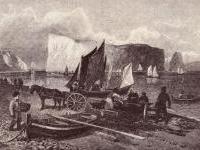 La Roche Percé, "the pierced rock," stands bold and firm to the end, though the cliffs of Mont Joli, on the mainland, and of Bonaventure Island, two miles out a sea, confirm the Indigenous tradition given by Denys that once there was no break in these perpendicular walls of rich-hued conglomerate, where the reds and browns of sandstone, the bright olives and greys of limestone, greens of agate, purples of jasper, white quartz, and deep-orange stain of iron blend together, and, seen against brilliant blue sky and emerald sea, form a wondrous combination of colour. But the waves, with unbroken sweep from the open ocean, beat fiercely on this marvellous rock, and have already battered down the three great arches Denys saw. Seventy years before Denys, Champlain says there was only one arch, which was large enough for a sloop under full sail to pass through.
La Roche Percé, "the pierced rock," stands bold and firm to the end, though the cliffs of Mont Joli, on the mainland, and of Bonaventure Island, two miles out a sea, confirm the Indigenous tradition given by Denys that once there was no break in these perpendicular walls of rich-hued conglomerate, where the reds and browns of sandstone, the bright olives and greys of limestone, greens of agate, purples of jasper, white quartz, and deep-orange stain of iron blend together, and, seen against brilliant blue sky and emerald sea, form a wondrous combination of colour. But the waves, with unbroken sweep from the open ocean, beat fiercely on this marvellous rock, and have already battered down the three great arches Denys saw. Seventy years before Denys, Champlain says there was only one arch, which was large enough for a sloop under full sail to pass through.
At present there is but one opening, forty or fifty feet high. Many remember the mighty crash with which the immense arch at the outer end of the rock fell just before dawn one morning about forty years ago, leaving as its monument the great monolith that formed its abutment. Slowly and surely wind and sea are doing their work; they have begun another aperture, not more than a couple of feet in diameter, through which the sunbeams flash as the eclipsing wave crests rise and fall.
On the north side is a tiny beach where you can land at low tide on a calm day. It is like a profanation to tread on the piles of agate and jasper glistening with water, whose every roll tosses up millions of pebbles for the sun to turn into rarest jewels. Myriads of fossils give to the face of the rock, that at a distance looks so hard and weather-worn, the appearance of an arabesque in richest velvet.
In this little cove, shut in by the cliff from sight of everything but the water and the sky, with no sound but the cries of the countless birds that tenant the dizzy heights, and the music of the surf as its thunderous bass dies away in rapid fugues to tenderest treble of clattering pebbles and dashing spray, we might sit and dream till the great, green rollers, through which a mysterious light gleams on weird shapes of trees and grottoes, and castles and palaces, carried us off willing visitors to the enchanted land they reveal.
Everywhere else the rock rises straight from deep water to a height of three-hundred feet. At its western end it is worn to a wedge as sharp and straight and clear-cut as the prow of an immense iron-clad, which it singularly resembles in outline, if one can imagine an iron-clad fifteen hundred feet long and three hundred wide.
Its top is covered with grass, but this is barely visible, because of the immense flocks of birds, winged armies ranged in serried order. Each tribe inhabits its own territory; the black cormorants never mingle with the white gulls; the great gannets and the graceful terns keep their own places. If any presumptuous bird wanders into the ranks of another tribe, there is a tremendous screaming and flapping of wings to drive away the intruder. They come and go incessantly, circling high over the schools of herring, and plunging deep to seize their prey; they swoop around the cod-fishers at anchor far out on the banks; they follow the boats in to the beach where the packers are at work; they flit like ghosts about the nets when in the silvery moonlight the fishermen go in quest of bait; but they return always to the one spot allotted to them among the densely packed mass of white, that from a distance looks like a bank of snow. During a storm their shrieking is almost unearthly, and can be heard for miles...